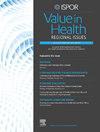矿皮质激素受体拮抗剂治疗缺血性和非缺血性心力衰竭伴射血分数降低的成本-效果:来自全民医疗保健系统的观点
IF 1.4
Q3 HEALTH CARE SCIENCES & SERVICES
引用次数: 0
摘要
目的矿盐皮质激素受体拮抗剂(MRAs)是治疗心力衰竭(HF)伴射血分数降低(HFrEF)的基石。最近推出了安全性更高的新型mra,如finerenone和eplerenone。然而,由于中等收入国家典型的预算限制,评估其成本效益对于优化治疗策略至关重要。方法采用贝叶斯网络和马尔可夫影响图估计每质量调整生命年(QALY)的增量成本-效果比(ICERs)。我们的模型通过系统评价和网络荟萃分析来比较MRAs的有效性,并使用来自1066名巴西HFrEF患者(36%为缺血性疾病,64%为非缺血性疾病)的队列数据。结果在10年的时间范围内,使用螺内酯、依普利酮和芬尼酮治疗与不使用MRA治疗相比,人均QALY折扣分别为0.072、0.111和0.034。icer分别为每QALY增值7955美元、6460美元和109840美元。与螺内酯相比,依普利酮的ICER为每增加一个QALY 6178美元。假设每个QALY获得1巴西人均国内生产总值(17589美元)的支付意愿阈值,概率敏感性分析表明,在87%和92%的迭代中,螺内酯和依普利酮分别具有成本效益。螺内酯的95% ci为2282至13149美元,每个QALY获得的人均ci为1795至12351美元。这些发现在包括缺血性/非缺血性心衰在内的几种情况下是一致的。结论在巴西,考虑到缺血性和非缺血性HFrEF患者,seplerenone可能是最具成本效益的MRA。本文章由计算机程序翻译,如有差异,请以英文原文为准。
Cost-Effectiveness of Mineralocorticoid Receptor Antagonists in Ischemic and Nonischemic Heart Failure With Reduced Ejection Fraction: Perspective From a Universal Healthcare System
Objectives
Mineralocorticoid receptor antagonists (MRAs) are cornerstones in the management of heart failure (HF) with reduced ejection fraction (HFrEF). New MRAs with improved safety profile, such as finerenone and eplerenone, were recently introduced. However, because of typical budget restrictions in middle-income countries, evaluating their cost-effectiveness is essential for optimizing treatment strategies.
Methods
We used a Bayesian network and Markov influence diagrams to estimate the incremental cost-effectiveness ratios (ICERs) in international dollars (Int$) per quality-adjusted life-year (QALY). Our model was fed by a systematic review and a network meta-analysis to compare MRAs effectiveness and used data from a cohort of 1066 Brazilian individuals with HFrEF (36% with ischemic and 64% with nonischemic disease).
Results
Over a 10-year time horizon, the treatment with spironolactone, eplerenone, and finerenone compared with no MRA utilization yielded discounted QALY per person of 0.072, 0.111, and 0.034, respectively. The ICERs were Int$7955, Int$6460, and Int$109 840 per QALY gained, respectively. Compared with spironolactone, eplerenone showed an ICER of Int$6178 per QALY gained. Assuming a willingness-to-pay threshold of 1 Brazilian per capita gross domestic product (Int$17 589) per QALY gained, the probabilistic sensitivity analyses suggest that spironolactone and eplerenone were cost-effective, respectively, in 87% and 92% of iterations. The 95% CIs were Int$2282 to Int$13 149 for spironolactone and Int$1795 to Int$12 351 for eplerenone per QALY gained. These findings were consistent across several scenarios including ischemic/nonischemic HF.
Conclusions
Eplerenone is likely the most cost-effective MRA in Brazil considering individuals with both ischemic and nonischemic HFrEF.
求助全文
通过发布文献求助,成功后即可免费获取论文全文。
去求助
来源期刊

Value in health regional issues
Pharmacology, Toxicology and Pharmaceutics-Pharmacology, Toxicology and Pharmaceutics (miscellaneous)
CiteScore
2.60
自引率
5.00%
发文量
127
 求助内容:
求助内容: 应助结果提醒方式:
应助结果提醒方式:


